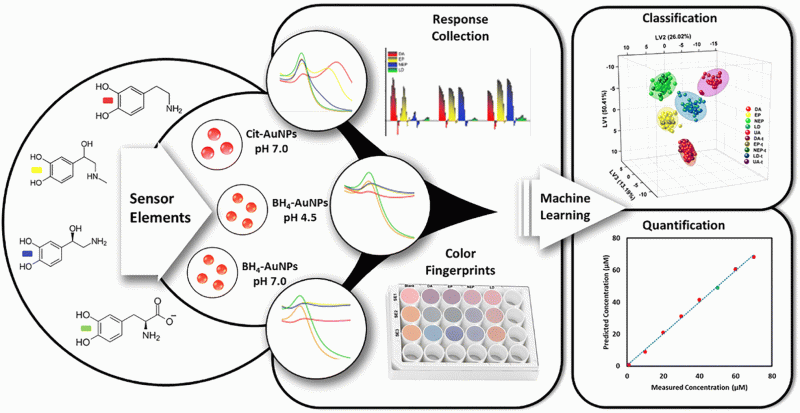- English
- فارسی
Machine-Learning Assisted Multiplex Detection of Catecholamine Neurotransmitters with a Colorimetric Sensor Array

Mahsa Hassani-Marand, Nafiseh Fahimi-Kashani and Mohammad Reza Hormozi Nezhad
Catecholamine neurotransmitters (CNs), such as dopamine (DA), epinephrine (EP), norepinephrine (NEP), and levodopa (LD) are recognized as the primary biomarkers of a variety of neurological illnesses. Therefore, simultaneous monitoring of these biomarkers is highly recommended for clinical diagnosis and treatment. In this study, a high-performance colorimetric artificial tongue has been proposed for the multiplex detection of CNs. Different aggregation behavior of gold nanoparticles in the presence of CNs under various buffering circumstances generate unique fingerprint response patterns. Under various buffering conditions, the distinct acidity constants of CNs, and consequently their predominant species at a given pH, drive the aggregation of gold nanoparticles (AuNPs). The utilization of machine learning algorithms in this design enables classification and quantification of CNs in various samples. The response profile of the array was analyzed using linear discriminant analysis algorithm for classification of CNs. This colorimetric sensor array is capable of accurate distinguishing between individual neurotransmitters and their combinations. Partial least square regression was also applied for quantitation purposes. The obtained analytical figures of merit (FOMs) and linear ranges of 0.6-9 µM (R2 = 0.99) for DA, 0.1-10 µM (R2 = 0.99) for EP, 0.1-9 µM (R2 = 0.99) for NEP and 1-70 µM (R2 = 0.99) for LD demonstrated the potential applicability of the developed sensor array in precise and accurate determination of CNs. Finally, the feasibility of the array was validated in the human urine sample as a complex biological fluid with LODs of 0.3, 0.5, 0.2, and 1.9 µM for DA, EP, NEP, and LD, respectively.
